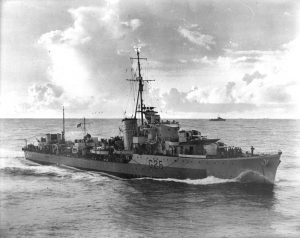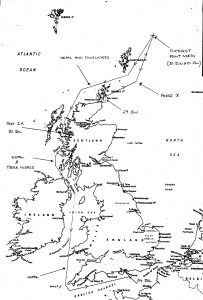- Author
- Letter Writer
- Subjects
- Ship histories and stories, WWII operations
- Tags
-
- RAN Ships
- HMAS Nepal
- Publication
- March 2017 edition of the Naval Historical Review (all rights reserved)
The Society received the following letter which explains this unusual circumstance.
A recent application to the Defence Honours and Awards Tribunal has cast light on a hitherto unknown operation undertaken by the destroyer HMAS Nepal in the Norwegian Sea in June and July 1942. Nepal formed part of the escort for a convoy which was intended to act as a decoy for German forces and thus provide a diversion for the key PQ 17 convoy to Russia. This effort had the code name of ‘Operation ES’.
No record of Nepal’s actions appears to exist in any Australian archive or published source. Both the official history of the RAN in World War II and the more recent volume by the Naval Historical Society on the history of the five N class destroyers in RAN service from 1941 to 1945 describe Nepal as having conducted only a work up at Scapa Flow before deploying to the Indian Ocean. UK records, however, confirms not only the details of the operation but Nepal’s involvement.
The Tribunal is of the view that the service of Nepal nd her crew should be recorded and publicised. I am therefore enclosing for you a summary of the Tribunal’s research and findings which I hope you will include in your archives and, if possible, publish. I am sure that making this significant episode more widely known to the Australian public would be a source of great satisfaction to the surviving personnel from HMAS Nepal, as well as to the families of the entire crew. While Convoy PQ 17 met with disaster for other reasons, it is clear that ‘Operation ES’ was a deliberate effort to draw aircraft, U-boats and even surface raiders away from the main convoy and one conducted at some risk to the ships involved.

Nepal was the fifth and last of five N class destroyers to be commissioned into the Royal Australian Navy. She was built by Thorneycroft at the company’s Woolston shipyard. Laid down in September 1939, she was originally to be named Norseman and was intended for transfer to the Royal Netherlands Navy. On 18 December 1940, the hull was badly damaged on the slipway in an air raid, delaying the launch of the ship until 4 December 1941 and forcing a change in the Admiralty’s intended distribution of the eight N class to Allied navies. She was reallocated for manning by the RAN, renamed Nepal (to honour the contribution of that country’s Ghurkha regiments to the war effort) in January 1942 and commissioned into the RAN on 11 May 1942.
Nepal completed her builder’s trials and initial rectification before sailing to Plymouth. She left there on the evening of 29 May 1942 and arrived at Scapa Flow to begin her work up for operational service on 31 May. Such a workup generally involved basic exercises and weapon firings to bring the crew to the required level of efficiency and identify any remaining material defects. It was, however, the practice to use destroyers which were working up to meet operational requirements for the Home Fleet, particularly those arising in the locality of Scapa Flow. On this basis,Nepalundertook an anti-submarine patrol with two British destroyers on 14 June in the vicinity of 60 degrees 40 minutes North and 5 degrees West. She returned to Scapa Flow on the evening of 15 June 1942 and otherwise appears to have worked in the local exercise areas when not anchored in the Flow.
Nepaland her sister, the Dutch destroyer Tjerk Hiddes, completed the required weapon practices by the end of June. At this point, both ships were due to return south to complete their final defect rectification and equipment fit before deploying to join the Eastern Fleet.
A critical convoy, PQ 17, was due to sail from Iceland to Russia on 27 June 1942. This was a large and heavily escorted convoy carrying vital supplies for Russia and its despatch and arrival were considered to have great political as well as operational significance. In high summer, however, and with powerful German air, submarine and surface forces, including the battleship Tirpitz, arrayed against the convoy, it was viewed as being extremely vulnerable. In an attempt to confuse the Germans and force them to divert some of their units away from PQ 17, Operation ES was set in train. This was a decoy convoy which was intended to proceed north-east into the Norwegian Sea from the main British naval base at Scapa Flow in order to attract attention from German reconnaissance units and lure the enemy into allocating forces to attack it.
Nepaland Tjerk Hiddeswere allocated to the escort of the decoy convoy. While such allocation was within the authority of the Commander-in-Chief of the Home Fleet and the Rear Admiral (destroyers) Home Fleet, it is possible that the ship’s commanding officers volunteered for the sortie in order to give their crews some operational experience before the long passage to the Indian Ocean. This is consistent with the testimony of crew members concerning the address to them by the captain, Commander F.B. Morris, RAN.
The decoy convoy, designated Force X, consisted of a naval minelayer and five merchant ships converted to minelayers, together with four colliers, with an escort of two anti-aircraft cruisers, six destroyers and four anti-submarine trawlers. It should be noted that the anti-aircraft cruisers Sirius and Curacoa had also been working up before their assignment to Operation ES. Under the command of the Rear Admiral (Minelayers), Rear Admiral T.B. Drew, OBE (2), the force sailed from Scapa Flow at 0400 on 29 June 1942.
The maximum sustained speed of the convoy was no more than 10 knots, given the presence of the colliers, and was more likely that of a normal ‘slow’ convoy, which was 8 knots. According to the British Admiralty’s originally classified Naval Staff History, Arctic Convoys 1941-45, Force X proceeded to a position 61 degrees 30 minutes North and 001 degree East before reversing course sometime on 30 June without being sighted by the enemy. This position is approximately 180 nautical miles from Scapa Flow and is consistent with the convoy maintaining a speed of advance of 8 knots after sailing. Force X did not immediately return to base, but at some time on 30 June reversed course and again proceeded to 61 degrees 30 minutes North and 1 degree East. After reaching this point once more on 01 July, the force then turned back to Scapa Flow.

The operational concept for Operation ES seems to have been focused on diverting the German air and surface threats. Analysis of the Speed-Time-Distance elements suggests that there was little risk of the convoy becoming embroiled with German surface ships, notably Tirpitz, since it did not remain long enough in the Norwegian Sea for any queuing by reconnaissance forces to take effect. Tirpitz could not have sailed and moved far enough west to intercept the convoy before the latter was too close to British coasts. However, there was a serious risk of significant air attack and this was probably the reason why two anti-aircraft cruisers were part of the convoy’s close escort.
Later on 1 July Force X divided in two. The minelayers, accompanied by Sirius, Nepal, TjerkHiddesand two other destroyers headed for the minelayer base (Port ZA) at the Kyle of Lochalsh on the Scottish West Coast, while the colliers and the remaining escort proceeded to Scapa Flow. Both convoys arrived at their intended destinations on 02 July. The minelayers all had maximum speeds of at least 16 knots and it is therefore likely that they proceeded as a ‘fast’ convoy with a speed of advance of up to 15 knots (but probably 12 or 13 with zig-zags). This is consistent with the distance between Force X’s final point in the Norwegian Sea and the Kyle of Lochalsh (approx. 330 n.m.), as well as that to Scapa Flow (180 n.m) for the slower ships.
Nepal appears to have been detached from the minelayers at the Kyle of Lochalsh on their arrival there and proceeded independently through the Irish Sea and into the English Channel to Portsmouth, it is likely that she remained in company with the similarly detached Tjerk Hiddes until the latter went into Liverpool for her own final shipyard work. Nepal made for Portsmouth and berthed at her builder’s yard which is nearer Southampton on 04 July after a 700 n.m passage from the Kyle of Lochalsh. She there underwent her final defect work and equipment fit before sailing for Greenock on 13 July 1942. She then departed UK waters for the Indian Ocean.
Convoy PQ 17 was to suffer terrible losses after a mistaken assessment that Tirpitz was on the point of attacking the convoy brought an Admiralty order for the ships to scatter. Isolated and undefended, most of the merchant ships were picked off by aircraft or U-boats. The fate of the convoy remains a controversial topic to this day. Nevertheless, Operation ES was clearly a significant attempt to confuse the Germans, disperse their efforts and reduce the pressure on the main convoy. It is clear that this episode of Nepal’s operational life has never been directly known to Australian authorities or historians. It is not mentioned in the official history of the RAN, or in the Naval Historical Society’s history of the RAN’s N Class destroyers. Operation ES did not succeed in its purpose, but was an attempt worthy of recognition, as is the part played by Nepaland her crew.
Notes:
- The reports of proceedings (ROPs) for HMAS Nepaldo not exist in the Australian or British archives for 1942 and therefore reconstruction of the ship’s movements has had to be done through alternative primary and secondary sources. Advice from the British Naval Historical Branch is that individual ship ROPs were not written by units in British home waters at this particular period and that any operation report would have been compiled by the force commander. Although a search of the British archives was conducted, including the files related to PQ 17, no report from Operation ES was found.
- Sources which do cast light on the operation include the Home Fleet and Home Fleet Destroyer Command War Diaries from the British National Archives (TNA ADM 199/427) which have been transcribed and are available online at www.naval-history.net, as well as the Rear Admiral (Minelayers) War Diary which is not available online, but was accessed at the British National Archives at Kew (TNA ADM 199/421).
Another important source is Arctic Convoys 1941-1945: Battle Summary No. 22, Naval Staff History Second World War issued as a Confidential Book (CB 3305(4)) in December 1954 by the Historical Section of the British Admiralty. Page 55 describes Operation ES and pp 53-71 PQ 17 and its other associated activities.
- On reaching age 55 Rear Admiral Drew was transferred to the Retired List. Seeking continued service he took a step down and was lent to the RAN as a Captain on 01 April 1943 as Commanding Officer HMAS Cerberus, a few months later on 26 June he was promoted as Commodore Superintendent of Training and in command of Cerberus. He was promoted Vice Admiral Royal Navy (in retirement on 21 July 1943) and was appointed a Commander of the Bath (CB) in the 1944 Imperial New Years Honours List. Commodore and Mrs Drew returned to England aboard SS Rimutakain November 1945 and his appointment to the RAN terminated on 13 March 1946 when he reverted to his Royal Naval rank of Vice Admiral.




